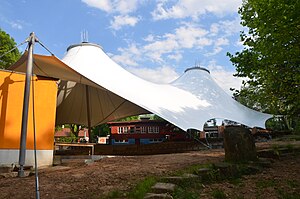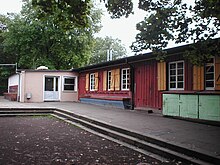Gaffenberg
| Gaffenberg | ||
|---|---|---|
|
Gaffenberg tent from 2013 |
||
| height | 278.1 m above sea level NN | |
| location | Heilbronn , Baden-Wuerttemberg | |
| Mountains | Heilbronn mountains | |
| Coordinates | 49 ° 7 '26 " N , 9 ° 14' 52" E | |
|
|
||
The Gaffenberg is a 278.1 m above sea level. NN high elevation in Baden-Wuerttemberg located Heilbronner mountains in Heilbronn .
The castle monument , the remnant of a former hilltop castle secured by ramparts and moats, lies on its spur that runs northeast . The mountain is best known for Europe's largest forest home for children's camps, the site of which has been the venue for the annual Gaffenberg Festival since 1986, with the exception of 2008 .
Geographical location
The Gaffenberg is located in the Heilbronn Mountains in the eastern city forest of Heilbronn - around 3 km (as the crow flies ) southeast of the city center. He is part of the protected landscape Gallows - Schweinsberg - Staufenberg . The Köpferbach flows past to the east .
Surname
The origin of the name Gaffenberg is unclear. The Gewann was first mentioned in a document in 1724, previously the mountain was regarded as the foothills of the Schweinsberg and its areas were named Burgmal and Hecken . The fact that a relatively small parcel was then named separately is probably related to a special use, possibly with the operation of a quarry. The term Gaffenberg is derived either from the Old High German noun kapf ('mountain top ') or from the New High German verb gaffen ('curious to look', motivated by the view from the height). As a field name, Gaffenberg occurs again in nearby Heilbronn- Frankenbach , otherwise the term is not represented in Württemberg as a mountain or field name, but it is in the Hessian Spessart.
Waldheim for children's camps
Europe's largest forest home for children's camps is located on the Gaffenberg. Its approximately 4 hectare site is located approximately 200 m west of the Köpfertal on the range of hills accompanying it on the left.
The children's camps on the Gaffenberg go back to the pastor Theodor Zimmermann (1893–1974), who had gained his first experience with the Waldheim idea after the First World War in the Stuttgart Waldheimen and from 1922 worked as a youth pastor in Heilbronn.
In 1925, the CVJM Heilbronn acquired 37 ares of land on the Gaffenberg, built a hall with a kitchen extension there and organized the first summer leisure time for 200 children in 1927 under the direction of Zimmermann. The main intention then was, and still is, to offer city children a rest on the outskirts. Zimmermann led the camp until 1935 before he was called to another pastor's position. He was followed by the new youth pastor Werner Reininghaus (1906–1983).
In 1935 the site was enlarged by a donation of 15 acres, and the YMCA transferred the entire facility to the Evangelical Church Community of Heilbronn in the same year in order to prevent confiscation by the National Socialists. In 1937 another 18 ares were bought. In 1938 the former construction works of Kilian's Church was opened on the site.
When war broke out in 1939, the NSDAP district leadership confiscated the area, which was now around 70 ares in size. However, she agreed to continue using it for children's camps. Various pastors held these during the war years. During the battle for Heilbronn in April 1945, the area was damaged and then plundered by American troops who equipped the Heilbronn camp with kitchen utensils and other furnishings .
After the end of the war, forest services were held in the former building works - which has been called the Forest Church since then - because the churches in Heilbronn city center had been destroyed. Despite the severe consequences of the war, a children's summer camp took place again in 1945. In 1946 the site was restored and further buildings were built, including a. also the first stage. In 1950 the site had electricity and water connections. In 1953, the area grew again due to an acquisition in the neighborhood. This time it was the 81 ares large KdF property , once belonging to the German National Handicrafts Association and later transferred to the organization Kraft durch Freude . In the period up to 1960, up to 1,000 children took part in the camps.
Since 1956 there has been the Köpferfestspiele every other year ; Under the direction of the volunteer holiday supervisors, the theater is played.
In 1959, additional areas were leased from the city of Heilbronn. In 1962 the site was partially terraced, and by 1966, a total of over 1,800 children could take part - thanks to two time-shifted free time periods. In 1968 the wooden houses Ho , Tschi and Minh were built and the previous wooden stage gave way to a massive stone stage, the audience seats are on terraces.
In 1970 two more forest areas were leased from the city of Heilbronn and additional land was acquired. The same thing happened in 1973, when the stage and audience areas were roofed over with a tent, the shape of which was modeled on that of the Munich Olympic Stadium; In 1991, a white tent in its old form replaced the previously orange roof. In 1976 the so-called new building was built , and the Friends' Association of Children's Camps was founded. In 1977, an administration and residential complex was built on the site last acquired; the city of Heilbronn contributed 40% of the construction costs, and 638,000 DM were granted in favor of the multi-purpose building. In 1994 there was another land purchase.
Since nothing had been done to preserve the building for years, there was a great need for renovation around 2010. The Heilbronner Bürgerstiftung supports the renovation of the Waldheim with a large-scale donation campaign. Under the motto SOS Gaffenberg - Save the Gaffenberg for our children , a total of 862,000 euros were raised from March to the end of July 2011. As start-up capital, the community foundation gave a basic stock of 100,000 euros from its own resources. The community foundation was able to acquire this in cooperation with the regional daily newspaper Heilbronner Demokratie. Part of the fundraising campaign included a charity soccer game by the Bayern Munich Allstars, a children's party organized by the service clubs and a large wine tasting by the regional winegrowers.
In the years up to 2014, the facility was comprehensively renovated with a total cost of over 2 million euros. The largest single item was the renewal of the membrane roof as well as the foundations and supports of the tent, for which over 500,000 euros were invested in 2013. Another important measure was the redesign of the so-called OT building , in which the carers are housed during the children's camps and which can in future also be used for other purposes outside of the camps.
On the Gaffenberg, around 180 volunteer helpers between the ages of 17 and 30 look after around 2200 children every year during summer camps. The area can be rented outside of these leisure times, so other events are also held there.
Gaffenberg Festival
On the occasion of the 60th children's leisure time in 1986, the supervisors of the leisure time held the Heilbronner Kulturtage and then founded the Förderverein Heilbronner Kulturtage eV , which subsequently held other events. The annual event on the Gaffenberg is now called the Gaffenberg Festival . Harry Mergel headed the club for the first 19 years . In 2005, Mergel became the cultural and social mayor of Heilbronn and handed over the management of the association to co-founder Rudi Faul.
The festival initially focused on regional artists, in 1988 the majority presented artists from what was then the Eastern Bloc. Since 1990 the focus has shifted to international stars as well as alpine rock and pop music in addition to cabaret and comedy of all kinds. In 2005 the festival had a budget of 630,000 euros. The 20th Gaffenberg Festival 2006 counted 15,000 visitors and the artists received fees totaling around 300,000 euros. The 21st Festival 2007 took place on a somewhat smaller scale, as only three instead of four tents were used. It had around 9,500 visitors and the artist budget was 255,000 euros. Artists who performed in 2007 include Procol Harum , Gianna Nannini , Martin Jondo , Juli , Killerpilze and Culcha Candela .
The 2008 Gaffenberg Festival was canceled due to the low attendance figures in the previous year. Since 2009 the festival has taken place annually on a somewhat smaller scale. In 2010 the festival moved to Heilbronner Deutschhof for one season, and in 2011 it moved back to its traditional location on Gaffenberg. In 2013, around 3500 visitors were counted on four evenings. Performing artists in 2014 included BAP , Pete York and Christoph Sonntag . In 2015, among others, Willy Astor , Hubert von Goisern and Gerhard Polt made guest appearances on the Gaffenberg. In the now almost 30-year history of the festival, over 500 mostly well-known artists have performed on the Gaffenberg. In 2016 the festival will pause again.
Individual evidence
- ↑ a b Map services of the Federal Agency for Nature Conservation ( information )
- ↑ Bauer 2000, pp. 285-288.
- ↑ In Lettgenbrunn , see this excerpt Map of BayernAtlasses .
- ^ Administrative report of the city of Heilbronn 1975-78, p. 46.
- ↑ SOS Gaffenberg at heilbronner-buergerstiftung.de
- ↑ http://www.stimme.de/heilbronn/nachrichten/region/region/sonstige-Der-Gaffenberg-ist-gerettet;art87698,3149239
- ^ Claudia Ihlefeld: A summer without the Gaffenberg Festival . In: Heilbronner Voice of December 28, 2007
- ↑ http://www.stimme.de/heilbronn/kultur/sonstige-Gaffenberg-Festival-Gross-geworden-und-gesundgeschrumpft;art11930,2189771
- ↑ http://www.stimme.de/heilbronn/kultur/Gaffenberg-Festival-3500-Besucher-an-vier-Abenden;art11930,2845746
- ↑ http://www.stimme.de/heilbronn/free/Gaffenberg-Festival-faellt-2016-aus;art132111,3494279
literature
- 50 × Gaffenberg - Children's camps 1927–1976 . Evangelical Church Community Heilbronn, Heilbronn 1976
- Gerhard W. Bauer: About the Heidenweg to the whore fountain. Dealing with affairs in the Heilbronn corridor . In: Heilbronnica. Contributions to the history of the city , Heilbronn City Archives, Heilbronn 2000, pp. 249–384.




